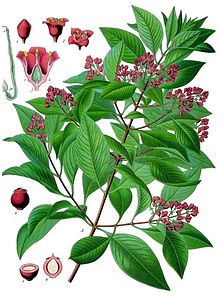
Santalum album

Santalum album, or Indian sandalwood, is a small tropical tree, and is the most commonly known source of sandalwood. It is native to Island Southeast Asia. Certain cultures place great significance on its fragrant and medicinal qualities. It is also considered sacred in some religions and is used in different religious traditions. The high value of the species has caused its past exploitation, to the point where the wild population is vulnerable to extinction. Indian sandalwood still commands high prices for its essential oil, but due to lack of sizable trees it is no longer used for fine woodworking as before. The plant is widely cultivated and long lived, although harvest is only viable after many years. Etymologically it is derived from Sanskrit चन्दनं chandanam. The height of the evergreen tree is between 4 and 9 metres. They may live to one hundred years of age. The tree is variable in habit, usually upright to sprawling, and may intertwine with other species. The plant parasitises the roots of other tree species, with a haustorium adaptation on its own roots, but without major detriment to its hosts. An individual will form a non-obligate relationship with a number of other plants. Up to 300 species (including its own) can host the tree's development - supplying macronutrients phosphorus, nitrogen and potassium, and shade - especially during early phases of development. It may propagate itself through wood suckering during its early development, establishing small stands. The reddish or brown bark can be almost black and is smooth in young trees, becoming cracked with a red reveal. The heartwood is pale green to white as the common name indicates. The leaves are thin, opposite and ovate to lanceolate in shape. Glabrous surface is shiny and bright green, with a glaucous pale reverse. Fruit is produced after three years, viable seeds after five. These seeds are distributed by birds. The nomenclature for other 'sandalwoods' and the taxonomy of the genus are derived from this species' historical and widespread use. Santalum album is included in the family Santalaceae, and is commonly known as white or East Indian sandalwood. The name, Santalum ovatum, used by Robert Brown in Prodromus Florae Novae Hollandiae (1810) was described as a synonym of this species by Alex George in 1984. The epithet album refers to the 'white' of the heartwood. The species was the first to be known as sandalwood. Other species in the genus Santalum, such as the Australian S. spicatum, are also referred to as true sandalwoods, to distinguish them from trees with similar-smelling wood or oil. Sandalwood is native to Island Southeast Asia and was first cultivated by the Austronesian peoples. It was introduced to the Dravidian peoples of southern India and Sri Lanka at around 1500 BC by Austronesian traders, along with other Austronesian food crops like coconuts and various spices and technologies like catamarans and outrigger canoes. Sandalwood is now cultivated in India, China, Sri Lanka, Indonesia, Malaysia, the Philippines and Northern Australia. S. album occurs from coastal dry forests up to 700 m elevation. It normally grows in sandy or well drained stony red soils, but a wide range of soil types are inhabited. This habitat has a temperature range from 0 to 38 °C and annual rainfall between 500 and 3000 mm. S. album can grow up to 30 feet vertically. It should be planted in good sunlight and does not require a lot of water. The tree starts to flower after 7 years. When the tree is still young the flowers are white and with age they turn red or orange. The trunk of the tree starts to develop its fragrance after about 10 years of growth. S. album is recognized as a 'vulnerable' species by the International Union for the Conservation of Nature (IUCN). It is threatened by over-exploitation and degradation to habitat through altered land use, fire (to which this species is extremely sensitive), Spike disease, agriculture, and land-clearing are the factors of most concern. To preserve this vulnerable resource from over-exploitation, legislation protects the species, and cultivation is researched and developed. Until 2002, individuals in India were not allowed to grow sandalwood. Due to its scarcity, sandalwood is not allowed to be cut or harvested by individuals. The State grants specific permission to officials who then can cut down the tree and sell its wood. The Indian government has placed a ban on the export of the timber.
